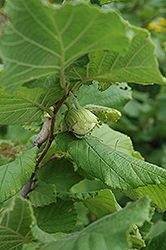Height: 15 feet
Spread: 10 feet
Sunlight:
![]()
![]()
![]()
Hardiness Zone: 4a
Other Names: European Hazelnut, European Hazel
Description:
A large sprawling shrub or small tree prized for its abundantly produced medium-sized nuts that are somewhat easier to remove from their shells than the species; a rather large plant, useful for screening or a natural forest setting
Edible Qualities
Butler Filbert is a large shrub that is typically grown for its edible qualities. It produces brown nuts which are usually ready for picking from early to mid fall. The nuts have a sweet taste.
The nuts are most often used in the following ways:
- Fresh Eating
Features & Attributes
Butler Filbert is draped in stunning brown catkins hanging below the branches from late winter to early spring before the leaves. The flowers are excellent for cutting. It has dark green deciduous foliage. The serrated round leaves turn yellow in fall. It produces brown nuts in mid fall.
This is a dense multi-stemmed deciduous shrub with an upright spreading habit of growth. Its relatively coarse texture can be used to stand it apart from other landscape plants with finer foliage. This plant will require occasional maintenance and upkeep, and can be pruned at anytime. It is a good choice for attracting squirrels to your yard. Gardeners should be aware of the following characteristic(s) that may warrant special consideration;
- Suckering
Aside from its primary use as an edible, Butler Filbert is sutiable for the following landscape applications;
- Hedges/Screening
- Naturalizing And Woodland Gardens
- Orchard/Edible Landscaping
Planting & Growing
Butler Filbert will grow to be about 15 feet tall at maturity, with a spread of 10 feet. It tends to be a little leggy, with a typical clearance of 2 feet from the ground, and is suitable for planting under power lines. It grows at a medium rate, and under ideal conditions can be expected to live for approximately 30 years. This variety requires a different selection of the same species growing nearby in order to set fruit.
This plant is typically grown in a designated edibles garden. It performs well in both full sun and full shade. It is very adaptable to both dry and moist locations, and should do just fine under average home landscape conditions. It is not particular as to soil type or pH. It is highly tolerant of urban pollution and will even thrive in inner city environments. This is a selected variety of a species not originally from North America.
Disclaimer - This resource is provided for informational purposes only and does NOT reflect current availability. Inventory varies seasonally, so we cannot guarantee that every plant will be in stock at all times - please contact your favourite GardenWorks location directly for current availability. It does not include our entire inventory of plants, so be sure to visit GardenWorks to see varieties that may not be represented on this list.

